Having successfully completed a relatively comfortable weekend on the hook making sure everything we would need to live comfortably worked, we were ready to stretch our legs even further. Coincidently, a lot of the big projects we were working on required outside services and vendors and we were rolling into August. In August, Spain, and most of western Europe, essentially shuts down. EVERYONE goes on vacation. All we kept hearing from the companies we were working with was that we wouldn’t be able get the parts we needed due to shipping delays and services wouldn’t be available until September due to short staffing. We could continue to sit on the dock OR take our own vacation to go check out two beautiful islands known for world class sailing that were not too far away!
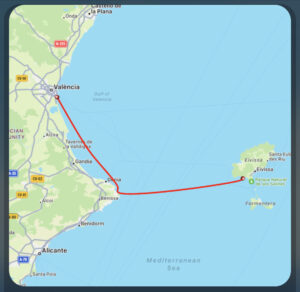
The Balearic Islands
The Balearic Islands are made up of four main islands: Mallorca, Menorca, Ibiza, and Formentera, each one with it’s own distinct character, customs, and traditions. With their stunning white-sand beaches, crystal-clear waters, and year-round sunshine, the Balearic Islands are a true paradise. Some fun random facts: The Balearic Islands have been part of the Spanish territory since 1349 and apparently they are really good at tennis. Both Rafael Nadal and Carlos Moya were both born on the Islands.
Since we were only spending a little over two weeks on this trip, we decided to explore only Ibiza and Formentera, the two western most islands. So this post will only cover those two islands including their history, current vibe, and what it was like to sail in this stunning part of the world!
Ibiza & Formentera: A little history and their current vibe
Ibiza and Formentera both have interesting diverse past and presents…
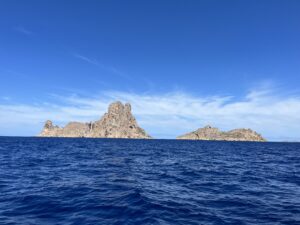
Ibiza, also known as the “White Island,” has been inhabited for thousands of years and has a colorful history that dates back to ancient times. The island was occupied by different cultures along the way including the Phoenicians, Carthaginians, Romans, Moors, and more. These diverse influences can still be seen throughout the island’s architecture, cuisine, and traditions. The island is immensely popular with tourists known vibrant nightlife, stunning beaches, and lively atmosphere. It’s full of world-class clubs with world-famous DJs playing nightly attracting partygoers from around the globe. Beyond the nightlife, Ibiza is home to some of the most beautiful beaches in the Mediterranean offering a wealth of natural beauty, a countryside of rolling hills, charming pine forests and hidden coves.
Formentera, on the other hand, is known for its tranquility and unspoiled nature. As the smallest of the Balearic Islands, it has a more laid-back vibe compared to its neighboring island Ibiza and is only accessible by boat. Formentera has a rich history connected to pirates, as the island provided a hiding place for them during the 16th and 17th centuries. Today, Formentera is beloved for its pristine white sandy beaches (some of the best in the world), crystal-clear turquoise waters, and scenic landscapes including hidden coves, pine forests, and salt flats. There are a few charming villages and one large “city”, Es Pejols, where you can get a taste of local life and authentic island culture. Formentera’s arts and crafts scene is also thriving, with galleries and studios showcasing local talent and creativity. The island’s bohemian vibe seems to attract a number of unique artists, musicians, and free spirits!
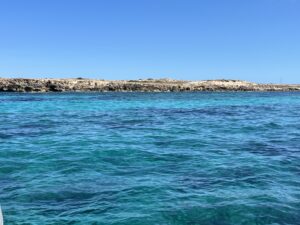
The Sailing
Throughout our trip in August, the sailing conditions around Ibiza and Formentera were generally favorable. The weather was warm and sunny our entire stay, with temperatures ranging from 25 to 35 degrees Celsius (77 to 95 degrees Fahrenheit). The winds were mostly gentle to moderate, offering pleasant sailing conditions mixed with some need for motoring between anchorages. A few times we needed to move to a more protected cove as winds picked up to 25+ kts. Our anchor dragged once, at a less than ideal time (see our stop in Sant Antonio in the next post for that story), and we did encounter our first storm at anchor, where sadly, we donated a fender to Poseidon (See: Cala Tarida). But, there was always somewhere to go to anchor safely and feel protected during those rare events. The sea itself was calm with gentle swells, making it ideal for anchoring in secluded coves and exploring the pristine beaches (of which there were many and they were BEAUTIFUL) with an occasional fun, lively loud spot mixed in.
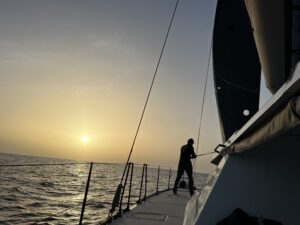
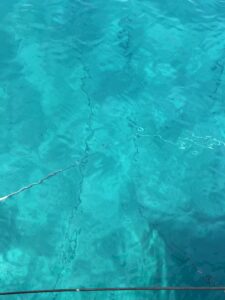
While we didn’t stay in any marinas or get any work done while we there, we can say they were numerous, but incredibly expensive! Thankfully, the anchorages were plenty and we usually found space despite it being the most popular travel season for the islands. We found both secluded coves to relax in and areas with charming towns and villages to explore full of trendy beach clubs, and bohemian-style bars, delicious local cuisine to sample, and a vibrant atmosphere to take in all along the coastlines.
And the water…I CAN NOT mention the water enough. Warm and clear pristine blue. It was truly incredible to see and swim in. Fish and underwater life was a fairly sparse, with the exception of small sunbeams (which follow you everywhere!), but we managed to find a few good snorkel spots along the way.
Seriously, we could see our 33Kg Rocna (~73lbs) anchor hanging out in 8m (~26ft) of water! Made anchor checks really easy!
Our biggest challenges sailing around the islands
Occasional blustery winds:
Some of the best advice we got about sailing around the Med, was to be aware of the wind conditions at all times. It can go from 4 kts to 40 kts and back on the drop of dime, sometimes quite unexpectedly. We experienced this very phenomenon on our trip to Ibiza, day 1 (which I’ll share in our next post!) We had to be aware of the weather changes every day, and we ended up bouncing around anchorages every other day or so just so we could relax in the best protected spot for that days conditions if winds were expected to pick up. We also had to be aware of how much anchor chain we had out…
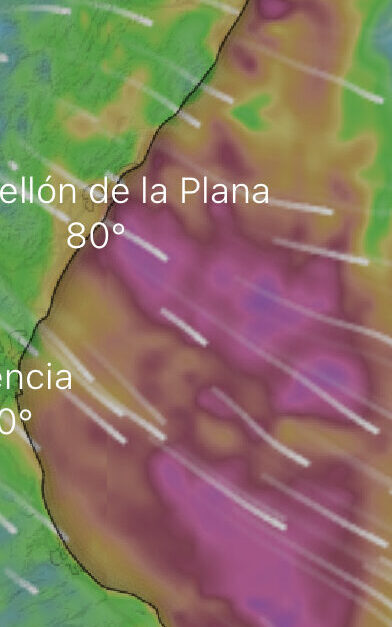
Deep Water:
On board with have 80m of anchor chain followed by 100m of rode. We usually aim for 6:1 scope when anchoring. For non-boaters, this means we let out 6m of chain for every 1m of depth. A little more goes into it and varies based on conditions, but that is the most basic explanation. With only 80m of chain, we were limited to just under 10m of water for anchoring in good conditions so we could relax. The Med is DEEP. Crossing to Ibiza, there was 800m (~2600 ft) under our keel. Anchorages generally ranged from 5m (up against the shoreline or cliffs) to 12m+. We would often have to drive around an entire anchorage just to find suitable area of 8-9m to drop anchor in, often pushing Erin’s comfort level having to get a bit closer than she would like to the neighboring rocky cliffs.
Crowded Anchorages:
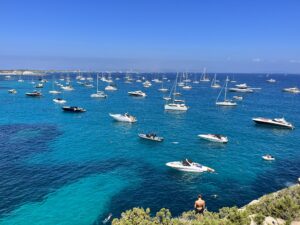
It was the peak of the summer seasons, so there was A LOT of boats from small mono-hauls to HUGE mega-yachts whose tenders may have been the size of our catamaran! This sometimes made it tough to find suitable anchoring spots where we could let out enough anchor chain to be safe, yet not bump into our neighbors. A fine line! Additionally, we found boats had all sorts of different anchoring plans with how much chain they let out, some only utilizing 4:1 and others going big with 8:10-1 or more. This made estimating our swing radius difficult at times! Additionally in some areas, there were limited areas within anchorages or limited areas due to the protected nature of certain coastal zones or the presence of posidonia seagrass meadows.
Navigation Hazards:
Like any other sailing destination, the Balearic Islands have their fair share of navigation hazards, such as reefs, underwater rocks, and shallow areas. It was crucial to have accurate and up-to-date nautical charts, use navigation instruments, and exercise caution when approaching what was to us a very unfamiliar area with some unforgiving terrain.
Despite these challenges, sailing in the Balearic Islands was an incredibly rewarding experience. With proper preparation, careful navigation, and a flexible mindset, we made the most of our first trip away from home base!
So where did we go, what did we see and experience?!
We actually sampled 9 different anchorages in 17 days encountering some of the most beautiful blue water and gorgeous sunsets we have ever seen. In our next post, we will cover our trip: the anchorages and more in depth sailing and touristy experiences we had along the way.